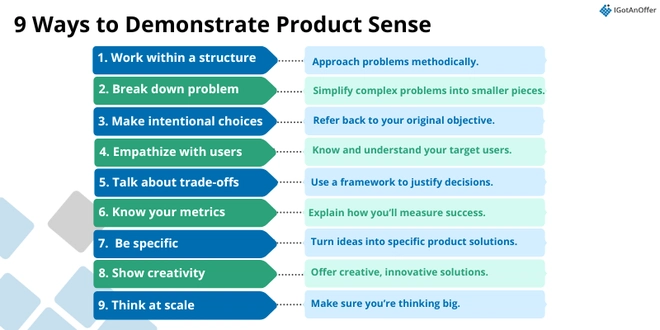Interviewing for a PM role at Meta? Then you’ll need to ace the product sense interview, one of the three core interviews that can make or break your candidacy.
Expect tough, open-ended questions like “How would you improve Facebook Groups?”, “Design a jobs product for Facebook”, or even “What should Meta do next?” These aren’t just about creativity. They test how you think, prioritize, and build products at scale.
In this guide, we’ll break down exactly what Meta looks for, with insider insights from an ex-Meta product lead. We’ll show you proven answer frameworks, and sample questions and answers from Meta experts. Finally, we give you expert tips and a prep plan you can rely on, so you can walk into your interview confident and ready.
Here’s an overview of what we’ll cover:
- What is the Meta product sense interview?
- How to demonstrate product sense
- Product sense answer frameworks
- Product sense interview questions for Meta PMs
- How to practice Meta product sense questions
Let’s get started!
Click here to practice with Meta PM ex-interviewers
1. What is the Meta product sense interview?↑
The product sense interview is one of three types of interviews you’ll face if you’re applying for a product manager role at Meta. The others are the “execution interview” and the “leadership & drive interview” (a behavioral type of interview).
As an ex-director of product outlines in this insider article on the Meta PM interview, Meta / Facebook often describes its product process as "Understand, Identify, Execute."
The product sense interview focuses on the first two parts of this process: how you work to understand the problem you are trying to solve, and how you identify the best way to start solving that problem. You’ll be tested on the third part - how you execute the solution - in the execution interview.
You will face product sense questions both at the first-round stage (phone or video interview) and at the onsite interview. On both occasions, you’ll start with the bigger picture before breaking the problem into smaller components. You’ll be expected to lead the conversation, and you’ll need to sketch out your answer on a whiteboard or the online equivalent.
Read our Meta product manager interview guide to understand how the product sense interview fits into the whole interview process.
1.1 What does Meta focus on in product sense interviews?
To ace your Meta product sense interview, you need to know what the company focuses on in its product process.
Expert coach Akila worked as a Product Lead at Meta for 8 years. And she says that it is the company’s obsession with user pain points that has allowed it to build successful consumer products at the billion-person scale. The same focus has given Meta the push to dip into hardware as well.
“There are always reasons to prioritize a product initiative. But, if the user is not at the heart of the product development process, it is almost guaranteed to be a failure.”
This user obsession is reflected in the product sense interview. Your Meta interviewer expects you to make user segmentation the “lynchpin of your interview,” as Akila describes it.
“If user segmentation is strong, it sets the rest of the interview up for a win. If that's weak or loosely defined, then the rest of the interview becomes hard.”
2. How to demonstrate product sense↑

Your Meta interviewer will be looking for good product understanding, the right instincts, awareness of the different factors and considerations at play, and enough creativity to breed innovation. If you’ve got all those things, you’ve got product sense.
To convince the interviewer that you possess these qualities, you’ll need to do these nine key things:
9 ways to demonstrate product sense
1. Work within a structure
You’ll need to show you can approach complex problems methodically, always keeping your original goal in mind. Have a framework to structure your thought process, and talk your interviewer through it step-by-step.
2. Break the problem down into pieces
Questions such as "How would you improve Facebook?" are so vast, they’re impossible to properly answer unless you break them down into smaller components. Your framework will help you here.
3. Make intentional design choices
You'll need to constantly be able to refer back to your original objective. That's your North Star, and the design choices you make should take you toward it.
4. Empathize with users
To make the right product decisions, you’ll have to understand who your users are, how to segment them, and how to target the right ones.
5. Talk about trade-offs
There will be numerous approaches and solutions to the problem the interviewer poses, and you’ll have to make tough choices. Discuss them within a prioritization framework to show the rationale behind your decisions.
6. Know your metrics
While the product sense interview isn’t as metric-focused as the execution interview, you’ll still need to give a strong explanation of how you’re going to measure success.
7. Turn ambiguity into specifics
It’s not enough to just have an interesting discussion with the interviewer. You’ll need to turn ideas into specific product solutions.
8. Show creativity
Showing a structured, coherent approach is only half the battle: try to offer creative, innovative solutions that go beyond the obvious.
9. Think at scale
To state the obvious, Meta is huge. Its products are used by billions of people. So as you outline your answer, make sure you’re thinking big.
To see some more useful guidance about what's expected of you in the product sense interview, check out this very helpful guide to the PM onsite interview from the Meta team.
2.1 Do product sense interview expectations vary per level?
No matter what level you’re applying for, you’ll be tested on your product sense at Meta. If you’re wondering whether its product sense interview expectations vary per level, the quickest answer is no.
“Product sense interviews check for basic product chops, which tend to be fairly consistent across levels,” Akila says, adding that the biggest determiner of leveling is actually the behavioral interview.
What she observed in her 8 years of interviewing over 200 Meta PM candidates is how candidates at different levels approach the interview.
Junior candidates tend to focus more on creative solutioning. Meanwhile, you can always tell a candidate has more experience when they tend to spend more time on user segments and pain points.
“There’s some wisdom to this,” Akila says, “As long as you're focusing on the right problems, you can always iterate on solutions.”
But, no matter what level you’re at, Akila’s top advice is to not get too caught up in problem definition. While defining problems is what PMs are paid big bucks for, you want to devote enough time to solutioning, as it is a critical part of the interview as well.
2.2 Product sense interview common pitfalls
According to Akila, here are the most common mistakes candidates make during Meta product sense interviews:
- Spending too much time on mission and user segments
- Defining user segments too loosely or not in a MECE manner
- Not bounding the problem well enough up top with reasonable assumptions
- Not tying back the solution to the prioritized pain of the prioritized user segment
- Being afraid to go deep into the specific prompt and using generic frameworks
These problems are interconnected, as most of them are somehow related to the user and their problem or pain point.
So, to avoid these pitfalls, Akila’s advice is to first go deep into the prompt and make reasonable assumptions to bound or constrain the problem. And then, put yourself in the shoes of the user, and walk through their journey in detail and identify pain points.
“Don't worry about generic frameworks or buzzwords. If you're solving a real user pain, and your solution makes sense, you've nailed the product sense,” Akila says.

2.3 How to develop product sense
If you’re looking to switch to product management from a different career, you’re probably wondering if you’ve got enough product sense to succeed.
The truth is, all of us have product sense. Akila says, “We're on a spectrum that keeps adjusting as we begin to take an interest in the different types of problems around us, and the creative ways in which technology can solve those.”
But relying on your intuitive product sense is not enough to land you a role at a company as prestigious as Meta. You have to build on it.
As someone who transitioned from a different career to the product space, Akila shares the best advice that she got to build one’s product sense:
“Whatever you're doing, look at the (hardware and software) products around you with the lens of a user and think about what you would improve about them.”
Right, now that you know more about product sense, let’s take a look at a couple of proven methods to help you with your interview.
3. Product sense answer frameworks↑
As we mentioned above, it’s very important that you use a framework to approach the problems you’ll face in your product sense interview.
PMs use frameworks all the time for a reason. They help you follow a logical process and establish some order in what is often a quite chaotic and ambiguous environment.
During your interview, you don’t need to keep your framework a secret. You can share it with the interviewer so they know how you've structured your thought process and can follow it with you.
There are three types of product sense questions you might be asked: product design, product improvement, and product strategy.
For all three, we recommend using two frameworks, which we’ll cover in detail below. However, there are plenty of other valid frameworks out there, and you can also come up with your own.
Here are the two that we recommend:
3.1 BUS framework
The BUS framework is a three-step approach to the product process.
- Business objectives. Ask clarifying questions, check your assumptions. Then outline how you will approach your answer. Finally, define the business objective based on your understanding of the prompt.
- User problems. Identify the different user types and select a focus. List user problems/pain points. Prioritize.
- Solutions. List solutions for every problem you identified. Prioritize solutions. Summarize your answer.
Check out our general product sense interview guide for a deeper dive into the framework.
The BUS framework’s main benefit is that it forces you to approach problems in a logical order: you only start considering solutions when you’ve first established the business objectives and have found a relevant problem that is impacting them.
That’s to say, it’s no good providing a solution to a problem if you can’t link it back to how this helps meet your business objectives.
It also makes it easy to pivot at any moment of the interview without losing your focus.
Learn how the BUS framework can be applied to each type of product sense question by reading our specific guides: product design and product improvement. You can also use the framework for product strategy, just without the "User problem" part.
3.2 Rohan Katyal’s framework
Rohan Katyal is currently a PM at Meta’s New Product Experimentation group, and his product frameworks are highly recommended by recruiters at the company. Here’s a look at his approach for product sense:
- Clarify. Understand the prompt and the status quo experience. Check your assumptions by asking the interviewer.
- Product Mission & Goal. State the goal of the product and how it furthers the company’s mission. For the favorite product question, why do you like the product, and what makes it better than others? To improve pthe roduct, what job does the product solve and for whom
- User Segmentation. Start with listing the broad user segments before prioritizing one segment to focus on. For example, Yelp’s services product has 2 primary users: businesses and customers. Businesses can further be segmented into independent single-person operations, large services company employees, and part-timers.
- User Needs & Pain Points. Do a comprehensive exploration of user needs, prioritize one, and discuss the pain points in the user’s journey.
- Solutions. Brainstorm multiple product solutions for the prioritized problem and user segment, then prioritize one.
We recommend checking out Rohan Katyal’s Medium page to dive deeper into his frameworks.
As you will see, it looks very similar to the BUS framework. We believe what might make it more effective is the way it breaks down the tasks under “Business problem” (Clarify and Mission) and “User problem” (User Segmentation and User Pain Points).
So if you keep forgetting to segment your users or state the product mission, then incorporate Katyal’s framework into your practice.
Once you’ve got a solid understanding of how to use either framework (or any framework of your choice), you’ll want to start putting it into practice. Let’s take a look at some example questions.
4. Meta product sense interview questions + sample answers from a FAANG expert↑
As we mentioned above, product sense questions can be broken down into 3 categories, with subtle differences between each:
- Product design questions will ask you to design a new product from scratch. They're to test if you can combine a strong eye for design and UX with an understanding of business objectives.
- Product improvement questions test the same thing, but instead, you'll be asked how you'd improve an existing product.
- Product strategy questions come from a more high-level perspective. They test your ability to understand competitive markets and to create a product roadmap that responds to the business strategy.
It’s also common to face a “favorite product question”, but these generally take the form of product improvement questions (e.g "What’s your favorite app? How would you improve it?").
4.1 List of real Meta product sense questions
We’ve analyzed the data on Glassdoor to find real questions asked in the Meta product sense interview for product managers. Twice, we’ve provided a link to a step-by-step approach to the problem that you can refer to as you practice answering it yourself.
Let’s take a look.
Example questions asked in Meta PM product sense interviews
Product design questions
- Design a social travel product for Facebook
- Design a jobs product for Facebook
- Design a product to help users find a doctor on Facebook
- How would you improve Facebook? (answer)
- Pick a Meta app / any product — how would you improve it?
- How would you improve Facebook groups?
- How would you improve Facebook birthdays?
Product strategy questions
- Facebook events is struggling. How would you turn it around? (answer)
- Should Meta enter the dating / jobs market?
- How would you monetize Facebook marketplace / messenger?
- What should Meta do next?
Check out our guides to product design, product improvement, and product strategy for deep dives into the topics and more questions to practice with.
4.2 Sample answer outlines + mock videos with Meta PMs↑
In this section, we’ll show you two mock interviews with our expert PM coach, Mark. He has interviewed over 1000 PM candidates, many of them at Meta, and has coached many to succeed at top tech companies.
As an exercise, watch each video and then pause throughout to construct your own answers. See how they compare. For your reference, we’ve also summarized the answers with outlines.
Let’s get started.
Design a fitness app for Meta
B — Business Problem
- Meta wants to expand beyond screen-based engagement into physical well-being, aligning with its mission of building community and bringing people closer together.
- Current challenge: too much of Meta’s ecosystem is digital-only; a fitness app provides a chance to connect users offline and foster healthier habits.
- Constraints: launch an MVP in 3 months, targeting the U.S. market first.
U — User Problem
- Target segment: users motivated by general fitness and health (broad reach + high impact).
- Key pain points for these users:
- Where to start / what to do → lack of guidance or inspiration on exercises.
- Who to do it with → low motivation when exercising alone, desire for social/community support.
- How to track progress → need for simple, accessible ways to measure activity and stay motivated.
S — Solution
- MVP: Meta Fitness Challenges
- Simple, approachable fitness challenges (e.g., walking, yoga, cycling, HIIT).
- Gamification through badges and achievements.
- Social integration: invite friends, connect with trainers, or join community groups.
- Lightweight tracking: progress dashboards, cross-device integration (not hardware-dependent).
- Future roadmap:
- Add live fitness events (group classes, streaming workouts).
- Build deeper integration with fitness trackers and nutrition guidance.
- Success metrics:
- Adoption: number of users joining challenges, new trainer sign-ups.
- Engagement: DAU/MAU, 30-day retention, challenge completion rates.
Watch the video below to see how Mark answers this product sense question.
Design a theme park app
B — Business Problem
Dubai is building a massive, world-class amusement park to rival Disney World, aiming to create an unforgettable experience.
Objectives:
- Deliver an exceptional user experience that drives word-of-mouth and repeat visits.
- Build strong monetization channels through upselling food, merchandise, photos, and premium attractions.
- The app must support both visitor delight and park revenue goals.
U — User Problem
- Primary segment: Parents (planners and chaperones) → responsible for kids and grandparents, making most decisions.
- Secondary segments: Kids (not app users but key beneficiaries), teenagers (social use, novelty factor), grandparents (low engagement with tech).
- Key pain points for parents in a large, complex amusement park:
- Navigation: “Where am I? Where do I go?”
- Discovery: Awareness of all rides, shows, and hidden attractions.
- Basic needs: Quickly finding food, restrooms, and essentials.
- Noise/environment: Difficulty hearing or receiving notifications in a loud, chaotic setting.
- Revenue tie-in: Ability to buy add-ons (photos, merchandise) and share experiences socially.
S — Solution
- Core features:
- Map-driven interface: Big buttons/icons for navigation; clear directions to rides and facilities.
- Attraction discovery: Highlight upcoming shows, hidden gems, and must-see rides on the map.
- Quick access utilities: “Nearest restroom” and “nearest food” shortcuts with real-time distance/ETA.
- Monetization integration:
- In-app ride photos, merchandise ordering, and premium attraction access.
- Links to dining reservations and upsell opportunities.
- Hero experience:
- Augmented reality (AR) photo and character experiences (e.g., stand with Star Wars characters).
- Drives social sharing → viral promotion of the park.
- Debug / future considerations:
- Line optimization (real-time wait times, suggestions).
- Environmental adjustments (heat, loudness, haptics).
- AI personalization (ride recommendations).
Watch Mark answer this product sense question in the video below:
Now that we've got a good sense of questions you might be asked, and have seen what good answers look like, let's move on to how to practice them.
5. How to practice product sense questions↑
We've coached more than 20,000 people for interviews since 2018. There are essentially three activities you can do to practice for interviews. Here’s what we've learned about each of them.
5.1 Learn by yourself
Learning by yourself is an essential first step. Moreover, product sense questions are open-ended, complex, and need practice. We'd recommend using the three guides we mentioned above - product design, product improvement, and product strategy - to get your head around how to construct your answer.
For an overview of the product design process at Facebook, watch this video by ex-VP of design at Facebook, Julie Zhuo.
We also recommend that you watch some mock interviews on our product management YouTube channel. That way you can see what an excellent answer looks like.
People often ask us if we offer prep courses. We don't, but if you'd like to buy one, we'd recommend the Product Alliance Flagship Meta PM course. It has some great Meta-specific insights and goes into pretty good detail.
Once you’re in command of the subject matter, you’ll want to practice answering questions. But by yourself, you can’t simulate thinking on your feet or the pressure of performing in front of a stranger. Plus, there are no unexpected follow-up questions and no feedback.
That’s why many candidates try to practice with friends or peers.
Already interviewed for your role and wondering how to deal with a possible rejection from Meta? Check out our Meta interview rejection guide.
5.2 Practice with peers
If you have friends or peers who can do mock interviews with you, that's an option worth trying. It’s free, but be warned, you may come up against the following problems:
- It’s hard to know if the feedback you get is accurate
- They’re unlikely to have insider knowledge of interviews at your target company
- On peer platforms, people often waste your time by not showing up
For those reasons, many candidates skip peer mock interviews and go straight to mock interviews with an expert.
5.3 Practice with experienced PM interviewers
In our experience, practicing real interviews with experts who can give you company-specific feedback makes a huge difference.
Find a Meta product manager interview coach so you can:
- Test yourself under real interview conditions
- Get accurate feedback from a real expert
- Build your confidence
- Get company-specific insights
- Learn how to tell the right stories, better.
- Save time by focusing your preparation
Landing a job at a big tech company often results in a $50,000 per year or more increase in total compensation. In our experience, three or four coaching sessions worth ~$500 make a significant difference in your ability to land the job. That’s an ROI of 100x!















